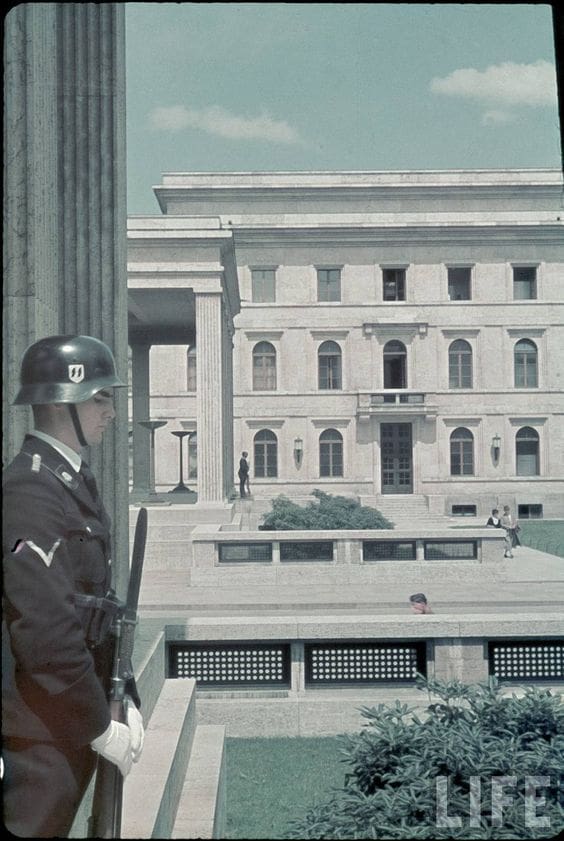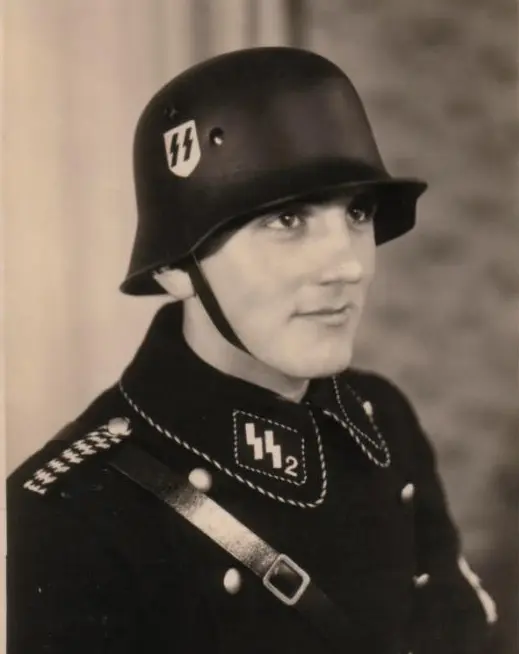
Sinister in Black, the Pre-War Helmet of the SS
A Infamous Helmet
If there is one helmet that is universally recognized as epitomizing the evil of the Nazis regime, it would be the shiny black helmet worn by the SS in the 1930s. It is hard to pinpoint exactly why. This type of helmet never saw combat. It wasn’t worn by concentration camp guards in large numbers. In truth, aside from parade and sentry duty, this famous helmet has a pretty limited service history. The murder and brutality meted out by the SS before and during WWII was for the most part not committed by men who were wearing these black helmets. Perhaps the association with evil is simple due to the sinister characteristic of the shinny black finish. Another possibility is the many existing news reels from the 1930s showing SS parades and rallies. The reels have been shown on television and in films to such a degree most people associate the SS with black uniforms and helmets. Whatever the actual reason, these infamous helmets are a symbol of the Third Reich’s evils. Today they have become highly desirable by museums and private collectors. Complete and authenticated helmets frequently sell in excess of 15k.
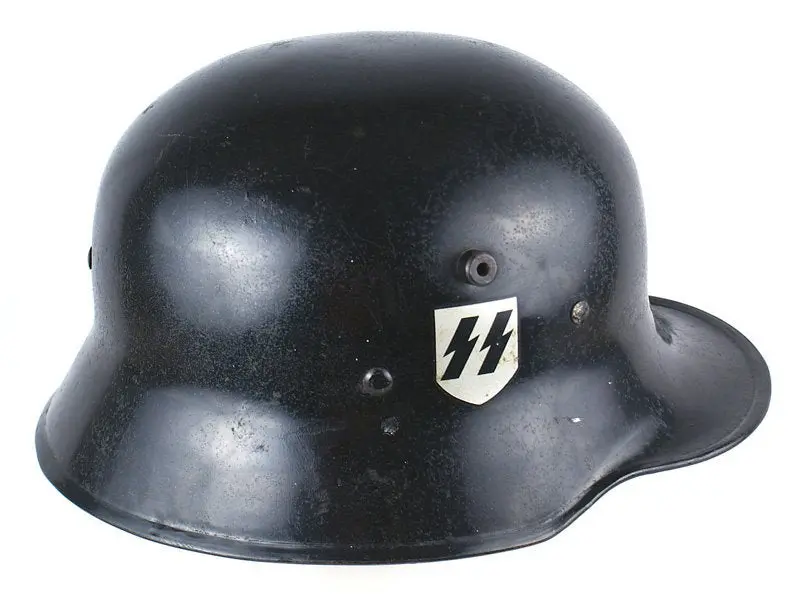
Why Black?
The earliest mention of the black helmet in the SS uniform regulations dates to July 1934. The regulation states a black M16 helmet is to be worn for parades and other special occasions. Despite the 1934 date, the black helmet was worn well before then. The need for a specifically black helmet can be traced back to Reichsführer Heinrich Himmler himself. Himmler ordered a new uniform to be designed for members of the SS, and it was adopted in 1932. The new uniform was black with a red armband and white leather gear. The triple combination was a nod to the colors of the old Imperial German flag. The black uniforms itself was also an attempt to connect SS troops to the past; the mounted elite life-guard regiments of the Prussian kings and emperors of Germany’s previous era who were also vested similarly in black. To further reinforce that connection, the peaked cap was fit with a leering skull or Totenkopf (death’s head) just as the fur busbies were of the old life-guard troopers.

Reguarless of the historic connections Himmler was trying to make with his new uniform, the trim SS-troopers definitely could project both authority and fear while wearing it. A number of foreign journalists reporting on events in Germany during the 1930s would comment on the feeling of intimidation in seeing the black uniformed SS. This seemed to suit Himmler’s aims as he would remark positively on hearing the negative feelings his new threads would evoke on journalists as well as the German population.

The Helmet
1932 was a bad time to need a helmet, and Himmler required a lot of them for his expanding SS units. At that moment, the German Reichswehr were still reliant on surplus WWI vintage M16 and M18 helmets. The Reichswehr (the German military) had barely enough helmets for their own use due to the restrictions the Treaty of Versailles placed on Germany in the prior decade. Had they wanted to share helmets with the SS (and they didn’t), Hitler was still a year from coming into power so the SS would have to look elsewhere for their needs. To cover the immediate short fall in 1932, helmets were drawn from old Freikorps as well as existing Nazi stocks.
After the Nazis came to power 1933, the SS would undergo rapid expansion and more helmets would be required. The SS supply officers would look abroad, and purchased surplus WWI era M17 Austrian helmets from Czechoslovakia and Austria, as the helmet design was virtually identical to the German Great War pattern. One wonders if the Czechs had a crystal ball, would they have been so willing to deal with the SS.

These helmets were reconditioned to SS specification by painting them black with a brush or pneumatic paint gun directly over the old WWI or 1920s era factory paint. Usually only the inside of the skirt was painted, while the dome was left still bearing the WWI era paint. Liners and chinstraps were reused or repaired as needed. In some cases new liners and chinstraps of varying designs were locally sourced and installed into these helmets.

Newly manufactured helmets were also commercially made within Germany to SS specifications. These commercial helmets varied in design by manufacture, but they were all basically produced in the style of the WWI German design. The commercially produced helmets are referred to by collectors with various names in an attempt to distinguish their basic difference. Appellations such as ‘droop bill, ‘M18 RZM’, or ‘Himmler helmet’ are just a few of such terms.

The M18 RZM helmet is one of the more unique of these versions, in that it was an attempt to standardize a combat helmet for the SS. In 1934, the Reich ministry in conjunction with the SS high command developed their own version of the Great War M18 helmet. While many of these helmets left the factory painted black for dress use, it was intended that these helmets would be worn by SS units in a future combat roll. Some originals are found over-painted with earth gray paint most likely for combat SS-VT units that fought in Poland.
While this helmet looks quite similar in appearance to Great War M18, it is easily distinguished by a RZM property stamp or Reichszeugmeisterei on the inside of the skirt. The Reichszeugmeisterei or National Ordinance Ministry was set up by the SS specifically to supply their camp guards and other personal within the organization.

The new helmets were ordered to be made of a high quality chromium steel. It would appear that this was never accomplished by the factory. Original RZM helmets often show considerable corrosion under the paint. The liners and chinstrap also tend to show poor quality and workmenship. This maybe the result of the economic situation at the time or the difficulty of obtaining chromium steel within the Reich during the 1930s.

Insingia
Various insingia were placed on helmets utilized by the SS during the 1930s. Initially when the SS started wearing the black helmet, it was void of any distinguishing markings. There are a few cases of a simple white swastika hand rendered to the side of the helmet, but normally the helmet was unadorned.

Starting in 1933, the so called ‘ SS Runes’ insignia was authorized to be worn by member of the Leibstandarte Adolf Hitler who had replaced the Reichswehr Chancellery Guard to become Hitler’s bodyguards. The SS-Runes were rendered onto the wearer’s right side of the helmet by hand or by means of a stencil.

The right of wearing the runes insingia was eventually extended to the other units within the SS in 1934.

SS helmet insingia would undergo numerous changes during the period of 1934 and 1935, and would differ by unit. The combat arm of the SS, or SS-Verfügungstruppen, SS-VT for short, adopted a large black Swastika outlined in white stenciled on the wearer’s right. The other side bore SS runes surrounded by two white circles. An examination of original photos as well as a handful of existing original examples would indicate these insignia were hand stenciled, although it is possible that a decal version existed.

The SS –Leibstandarte or ‘SS-LAH’ modified it’s helmet insingia on February 23, 1934. The new insingia was a black shield outlined in white, bearing SS runes on the wearer’s right. The shield was applied directly below the helmet’s ventilation lug. The other side of the helmet had a tri-color shield of black, white and red similar to the shield already worn on helmets of the Reichswehr.

The use of these unit specific helmet insingia was short lived in the SS. On August 12, 1935, SS headquarters issued an order that all units within the SS were to utilize the same insingia.


The new insignia would consist of a SS runes shield on the wearer’s right, and a National Socialist Party shield on the left. The new insingia were ordered to be painted in oil and to be completed by the opening of the Reichsparteitag.

Decals
The August 12 order specifying the insingia was to be rendered in oil was short lived. Two days later an order was issued specifying that insignias were to be made in decal form instead of being hand painted. Surviving records indicate the new decals were designed by Professor Hans Hass. The transfer insignia were ordered from a Nurnberg firm under the auspices of the SS Administration offices. They were sold in pairs at a cost of 25 Reichsmarks per 1000 sets. It should be noted that helmet decal insignia had been utilized by the Reichwehr as early as 1933, and had also been used on a limited basis by various groups within the SS prior to the August 14th order. Still these new transfer insignia would insure consistency among the various organization within the SS. The decals also had the added benefit of being clean and crisp which is not always the case with hand rendered insignia. Some original hand painted insignia show little actual artist skill in the application.
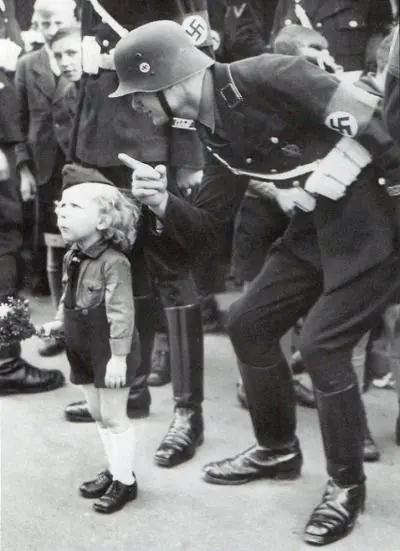
The new decals were to be applied to the helmet 3 mm under the ventilation lug with the use of dammar varnish, ducolux or Kopal lacquer. The varnish/lacquer was brushed onto the helmet’s surface and some time was allowed to pass until the medium became tacky to the touch. The decal was then placed into position, and patted down with a wet sponge to assure total adherence to the helmet’s surface. After 24 hours the decal would be thoroughly set into place.
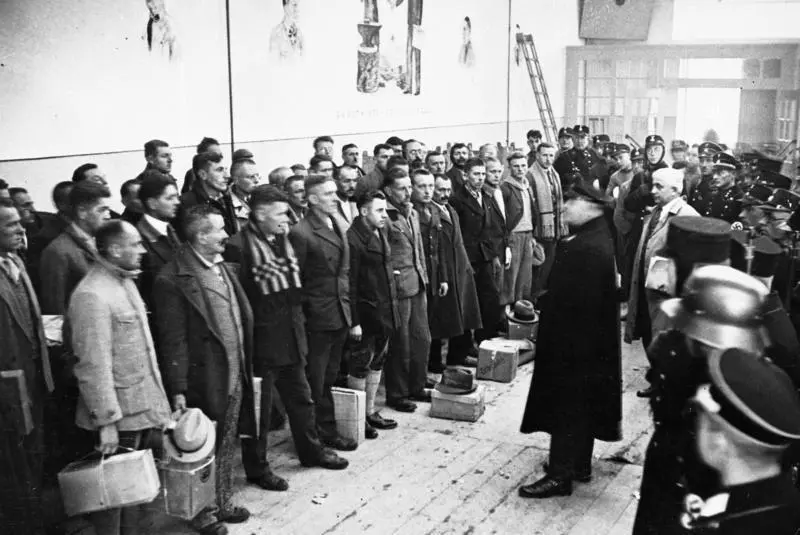
Concentration Camp Usage
Thanks to Hollywood or maybe just due to the color black’s association with death, many today believe these helmets were the standard headgear of the SS-concentration camp guards. Camp guards were from a unit known as SS-Totenkopfverbände or SS-TV. Members of the SS-TV certainly were issued these black helmets. Men appear wearing them is numerous studio photos as well as parades. Member of the SS-TV are fairly easy to distinguish with death head insignia on their tunic’s right collar tab. Still conventional wisdom dictates that these helmet would have been impractical in the SS camp system. The glossy finish were intended for parades, rallies and guarding the Chancellery. While it is easy to dismiss their use as Hollywood dramatic license, these helmets did make an appearance in the Nazi concentration camps during the 1930s. Soon after the SS took over the administration of the camps, the guards and other officials were vested in the same black uniform as the rest of their comrades. Photos taken prior to 1935 show guard wearing soft caps almost exclusively while on duty within the camps. Black steel helmets only appear in use by sentries at the front of the camp, in most cases. By 1935 the black uniform was seen as being impractical for camp guards. A new working uniform of earth-brown was adopted which would be worn there after. The black helmets would continue to be relegated for inspections and gate sentries within the camp system.

Removed From Service
As it became clear that Nazi Germany was steering toward war, the roll of the SS would change. The showy black helmets and uniforms would give way to a field gray uniform similar to that of the army. The new uniform was suited for combat not the parade ground. The last time the black helmets and uniforms were worn in mass by the SS was during the victory parade following the fall of France in 1940. From there on out these helmets were seldom seen outside some ceremonial guard units within Germany such as at the Reich Chancellery. In 1942 Himmler ordered the black uniforms stripped of insignia and turned in to equipment depots. The helmets themselves were put into storage or in many cases refurbished for combat. Original examples are sometime found with layers of matte field gray paint brushed over the black glossy parade finish. These helmets would have been worn by the combat SS-VT units who fought in Poland and later France.
As the war ended and Allied troops poured into the vanquished Reich, souvenir hunting GI and Tommies found these old black parade helmets to be irresistible. Certainly they would have seen these helmets as a symbol of the ideology they had taken part in defeating. Many of these helmets were procured from SS equipment depots or looted from various sources.
While these helmets certainly never saw combat, they do indeed stand as a silent witness of the rise of the Third Reich and the calamity that would pour out into the world.
